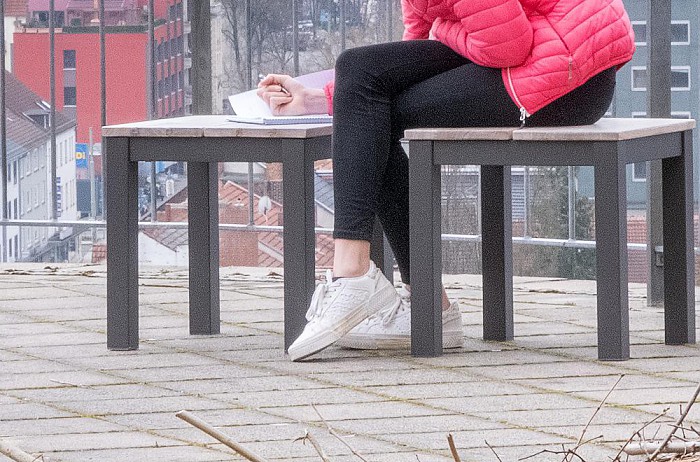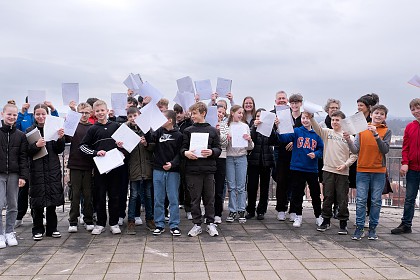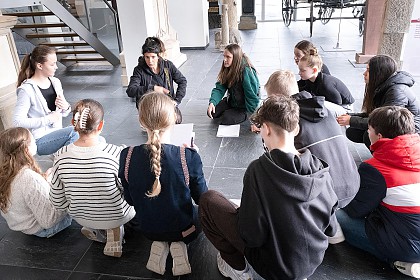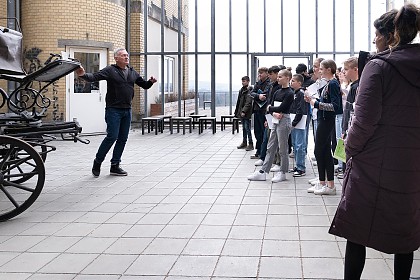

Death and Mourning as Literary Inspiration
hr2 pupils' project Young Literary Land Hessen at the Museum for Sepulchral Culture
A great treasure of inspiration for writing texts of all kinds awaits in the Museum for Sepulchral Culture. This was confirmed by the visit of students from Kassel's Lichtenberg Gymnasium in March – one of three Hessian schools participating in the Hessian Broadcasting Corporation's "Young Land of Literature Hessen" project, which aims to get young people interested in literature. Inspired by the contents of the permanent exhibition, they wrote texts in the presence of author and spoken word artist Dominique Macri, which will be set to music for the hr2-kultur website in the next step.
Accompanied by Dominique Macri and museum educator Gerold Eppler, the young people explored the museum in the first part of the workshop. During a guided tour of the permanent exhibition, they discovered gravestones, various urns and coffin forms, as well as something completely new: vanitas paintings, shrouds, jewelry made from the ashes and hair of the deceased. The way artists deal with their own death, which is the theme of the exhibition, also caused a sensation.
"Death is a taboo subject that is often excluded. But it offers many points of contact. And when something inspiring emanates from a place, great texts can emerge," says Dominique Macri. For the students, she says, it's about creating something; finding a voice for their own feelings. "Coming to terms with your own finitude can put you in touch with yourself. There's no more exciting topic for such introspection than death and dying."
The students* had an hour to engage with the museum's content, then presented their text ideas. Several students took the Vanitas paintings as an opportunity to reflect on death and dying. For example, 13-year-old Kaitlyn first wrote a text about her father, who died when she was four. "I was inspired by the pictures because I think life should be used," said 13-year-old Lea.
"I often reminisce and realize that we could have many more memories. Our time on earth is far too short. You often don't realize that until the time is up. But that's the most important thing: always thinking back to the people you care about," Kaitlyn, 13, writes about her father's death. "When my grandma went into a nursing home, we visited her regularly. But then when she died, I was sad because I felt like I didn't make enough use of my time with her." Finn (12), on the other hand, formulated a letter to himself in which he listed all the things to consider in life. Leonie (12) was inspired by the hair of deceased people and took it upon herself to write a letter to her rabbit Blacky. "Hair is a precious memento with which the dead are remembered. It makes me think of my pets. Maybe the next time one of my rabbits dies, I'll save some hair from him." Elisa (12) developed the idea for a text about living well. "I want it to be a recipe for how to enjoy life, focusing on having a good time with friends and family and your animals." Adrian and Arvid, both 12, thought it was "a bit over the top" to turn ashes of deceased people into jewelry. "That would be like having my ear to the ground all the time." They reflected on their thoughts in the text. The 13-year-old Elias brought an urn with a Schalke logo to a text idea. "It's about a boy who is an Ajax Amsterdam fan." Many students* reflected on death in their texts.
"You spend your life preparing for death and wondering what it might be like, no one knows, but what I think is that it's not bad at all. Rather, it's nice to see your friends and family again. Don't think so much, enjoy the time with your loved ones!" said Josephina. Angelina, in a text to her late great-uncle, expressed her sadness at not having spent enough time together. "I have so many gaps in my memory and would love to talk to you again. But I can't ask you anything anymore." And Angelina, 13, said, "Life itself is paradise. We should cherish that. You can't change what happens after death, but you can change life."
"There is so much wisdom in your words. I think it's very brave of you to share your thoughts with the group," Macri said in closing.
For museum educator Gerold Eppler, the main task was to get the students to take the exhibits out of their museum context and place them in a new one. "This resulted in imaginative fictional stories, but also texts in which the young people reflected on death and life. Some of this became very private: painful memories came to the fore, experiences of loss were put into words." The "Young Literature Land Hessen" is a great project that also shows how much students open up outside of the school context. Because the museum is not about being judged. "After all, the pupils* also learn something about their classmates. This exchange promotes social interaction."
Arbeitsgemeinschaft Friedhof und Denkmal e.V.
Zentralinstitut für Sepulkralkultur
Museum für Sepulkralkultur
Weinbergstraße 25–27
D-34117 Kassel | Germany
Tel. +49 (0)561 918 93-0
info@sepulkralmuseum.de











